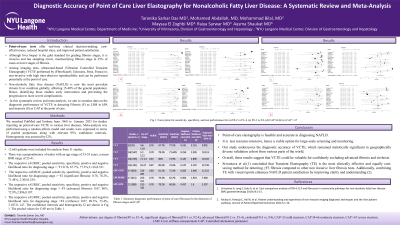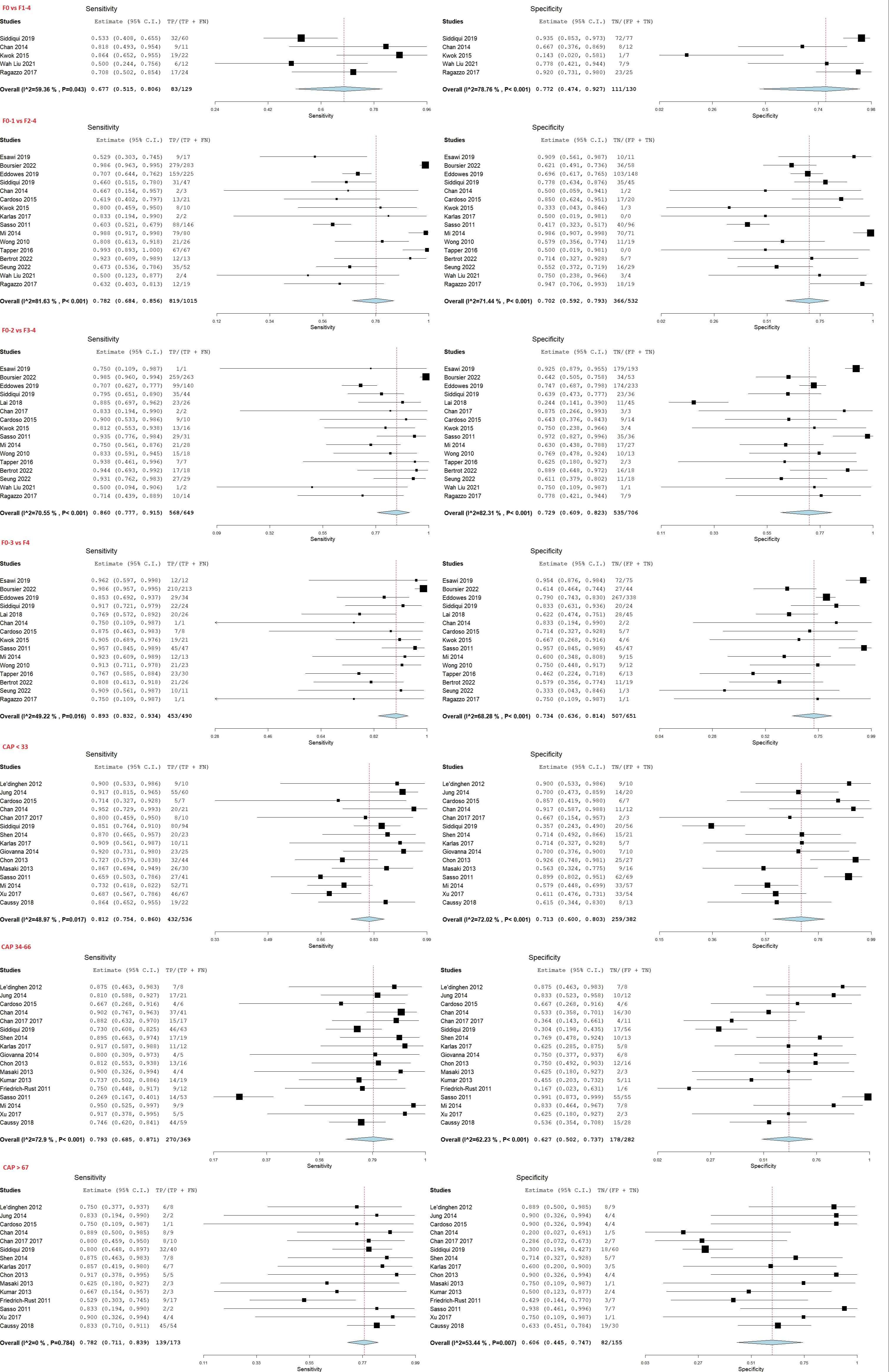Tuesday Poster Session
Category: Liver
P3824 - Diagnostic Accuracy of Point of Care Liver Elastography for Nonalcoholic Fatty Liver Disease: A Systematic Review and Meta-Analysis
Tuesday, October 24, 2023
10:30 AM - 4:00 PM PT
Location: Exhibit Hall

Has Audio

Taranika Sarkar Das, MD
NYU Langone Health
Brooklyn, NY
Presenting Author(s)
Taranika Sarkar Das, MD1, Mohamed Abdallah, MD2, Mohammad Bilal, MD3, Maysa El Zoghbi, MD4, Aasma Shaukat, MD5
1NYU Langone Health, Brooklyn, NY; 2University of Minnesota, Minneapolis, MN; 3Minneapolis VA Medical Center, Minneapolis, MN; 4NYU Langone, Brooklyn, NY; 5NYU Langone Health, New York, NY
Introduction: Point-of-care tests offer real-time clinical decision-making, cost-effectiveness, reduced hospital stays, and improved patient satisfaction. Liver biopsy, although the gold standard for fibrosis grading, is invasive and often misclassifies 25% of lower stage fibrosis cases due to sampling errors. Among imaging tests, ultrasound-based (Vibration Controlled Transient Elastography) VCTE by FibroScan is non-invasive with high inter-observer reproducibility and can be performed potentially at the point of care. Non-alcoholic fatty liver disease (NAFLD) is now the most prevalent chronic liver condition globally, affecting 15-40% of the general population. Hence, identifying those enables early intervention and preventing the progression to more severe complications. In this systematic review and meta-analysis, we aim to examine data on the diagnostic performance of VCTE in detecting Fibrosis (F) as LSM in kPA and steatosis (S) as CAP at the point of care.
Methods: We searched PubMed and Embase from 1960 to January 2023 for studies reporting on point-of-care VCTE in various liver diseases. Meta-analysis was performed using a random-effects model and results were expressed in terms of pooled proportions along with relevant 95% confidence intervals. Heterogeneity was assessed by I2%.
Results: Analysis included 11,665 patients from 31 studies, mostly males aged 35-55 years with mean BMI range of 23-41 kg/m2. The respective sAUROC, pooled sensitivity, specificity, positive and negative likelihood ratio for diagnosing stage >−F1:0.76, 67.7%, 77.2%,3.116,0.531. The respective sAUROC, pooled sensitivity, specificity, positive and negative likelihood ratio for diagnosing stage >−F2 (significant fibrosis): 0.78, 78.2%, 71.44%, 2.305,0.254. The sAUROC, pooled sensitivity, specificity, positive and negative likelihood ratio for diagnosing stage >−F3 (advanced fibrosis): 0.87, 86%, 72.9%,2.896,0.187. The sAUROC, pooled sensitivity, specificity, positive and negative likelihood ratio for diagnosing stage =F4 (cirrhosis): 0.87, 89.3%, 73.4%, 3.107,0. 147. The confidence intervals and heterogeneity I2 are shown is Fig 1. The pooled values for CAP are in Table 1.
Discussion: Point-of-care elastography is feasible and accurate in diagnosing NAFLD. It is less resource-intensive, hence a viable option for large-scale screening and monitoring. Our study underscores the diagnostic accuracy of VCTE, which remained statistically significant in geographically diverse validation cohort from various parts of the world.

Disclosures:
Taranika Sarkar Das, MD1, Mohamed Abdallah, MD2, Mohammad Bilal, MD3, Maysa El Zoghbi, MD4, Aasma Shaukat, MD5. P3824 - Diagnostic Accuracy of Point of Care Liver Elastography for Nonalcoholic Fatty Liver Disease: A Systematic Review and Meta-Analysis, ACG 2023 Annual Scientific Meeting Abstracts. Vancouver, BC, Canada: American College of Gastroenterology.
1NYU Langone Health, Brooklyn, NY; 2University of Minnesota, Minneapolis, MN; 3Minneapolis VA Medical Center, Minneapolis, MN; 4NYU Langone, Brooklyn, NY; 5NYU Langone Health, New York, NY
Introduction: Point-of-care tests offer real-time clinical decision-making, cost-effectiveness, reduced hospital stays, and improved patient satisfaction. Liver biopsy, although the gold standard for fibrosis grading, is invasive and often misclassifies 25% of lower stage fibrosis cases due to sampling errors. Among imaging tests, ultrasound-based (Vibration Controlled Transient Elastography) VCTE by FibroScan is non-invasive with high inter-observer reproducibility and can be performed potentially at the point of care. Non-alcoholic fatty liver disease (NAFLD) is now the most prevalent chronic liver condition globally, affecting 15-40% of the general population. Hence, identifying those enables early intervention and preventing the progression to more severe complications. In this systematic review and meta-analysis, we aim to examine data on the diagnostic performance of VCTE in detecting Fibrosis (F) as LSM in kPA and steatosis (S) as CAP at the point of care.
Methods: We searched PubMed and Embase from 1960 to January 2023 for studies reporting on point-of-care VCTE in various liver diseases. Meta-analysis was performed using a random-effects model and results were expressed in terms of pooled proportions along with relevant 95% confidence intervals. Heterogeneity was assessed by I2%.
Results: Analysis included 11,665 patients from 31 studies, mostly males aged 35-55 years with mean BMI range of 23-41 kg/m2. The respective sAUROC, pooled sensitivity, specificity, positive and negative likelihood ratio for diagnosing stage >−F1:0.76, 67.7%, 77.2%,3.116,0.531. The respective sAUROC, pooled sensitivity, specificity, positive and negative likelihood ratio for diagnosing stage >−F2 (significant fibrosis): 0.78, 78.2%, 71.44%, 2.305,0.254. The sAUROC, pooled sensitivity, specificity, positive and negative likelihood ratio for diagnosing stage >−F3 (advanced fibrosis): 0.87, 86%, 72.9%,2.896,0.187. The sAUROC, pooled sensitivity, specificity, positive and negative likelihood ratio for diagnosing stage =F4 (cirrhosis): 0.87, 89.3%, 73.4%, 3.107,0. 147. The confidence intervals and heterogeneity I2 are shown is Fig 1. The pooled values for CAP are in Table 1.
Discussion: Point-of-care elastography is feasible and accurate in diagnosing NAFLD. It is less resource-intensive, hence a viable option for large-scale screening and monitoring. Our study underscores the diagnostic accuracy of VCTE, which remained statistically significant in geographically diverse validation cohort from various parts of the world.

Figure: Figure 1. Forest plots of all included studies for the diagnosis of different stages of fibrosis using Point-of-care elastography.
Disclosures:
Taranika Sarkar Das indicated no relevant financial relationships.
Mohamed Abdallah indicated no relevant financial relationships.
Mohammad Bilal: Boston Scientific – Consultant.
Maysa El Zoghbi indicated no relevant financial relationships.
Aasma Shaukat indicated no relevant financial relationships.
Taranika Sarkar Das, MD1, Mohamed Abdallah, MD2, Mohammad Bilal, MD3, Maysa El Zoghbi, MD4, Aasma Shaukat, MD5. P3824 - Diagnostic Accuracy of Point of Care Liver Elastography for Nonalcoholic Fatty Liver Disease: A Systematic Review and Meta-Analysis, ACG 2023 Annual Scientific Meeting Abstracts. Vancouver, BC, Canada: American College of Gastroenterology.
